The United States government faces an imminent shutdown as the House of Representatives failed to pass a crucial funding bill. With the holidays approaching, political tensions soared as the vote followed intense lobbying and public controversy.
A Tumultuous Week on Capitol Hill
The House vote on Thursday concluded with a striking 174-235-1 result, pushing the government closer to a partial shutdown. Thirty-eight Republicans defied President-elect Donald Trump by voting against the pared-down spending bill. The failed vote marks a dramatic end to a week filled with shifting political alliances and high-stakes negotiations.
Earlier in the week, lawmakers seemed poised to approve a bipartisan spending resolution. However, Trump publicly denounced the initial bill, urging Republicans to renegotiate and warning of political consequences for those who didn’t comply. This move caused significant upheaval, ultimately leading to the introduction of a stripped-down version of the legislation.

Elon Musk’s Role in the Debate
Billionaire Elon Musk, recently appointed to lead the Department of Government Efficiency, played a pivotal role in the debate. Musk openly criticized the original spending resolution, highlighting unrelated provisions like pay raises for lawmakers and pandemic preparedness. He used his platform on social media to rally support for a government shutdown until Trump’s inauguration.
“This shows how much your voice matters!” Musk posted on X, formerly Twitter. “And having a President like @realDonaldTrump means that your voice is finally heard.”
Musk’s influence appears to have swayed Trump, who then called for a renegotiation of the bill. Lawmakers across the aisle have expressed concerns about Musk’s outsized role in shaping policy decisions. Despite these criticisms, Trump has denied that Musk wields undue influence over him.
What Was Cut from the Bill?
The pared-down resolution introduced on Thursday was significantly smaller in scope than the original bipartisan proposal. Among the programs removed were funding for child cancer research, premature labor research, sickle cell disease treatment, early cancer detection initiatives, and Down syndrome research. Additionally, an anti-deepfake pornography bill was excluded.
The revised bill aimed to keep the government funded through mid-March and suspend the nation’s debt ceiling until January 2027. Despite these measures, it failed to garner enough support, leaving the government in limbo.
Democratic Frustration Boils Over
House Democrats expressed growing frustration over the chaotic series of events leading to the failed vote. Reports indicate that chants of “hell no” echoed during a caucus meeting before the vote. Democrats criticized the cuts to essential programs and denounced what they saw as partisan gamesmanship.
The failure to pass the resolution has heightened fears of a partial government shutdown. If lawmakers cannot reach an agreement, many government agencies will lose funding, and thousands of federal employees will face unpaid holidays. This scenario threatens to disrupt vital services and undermine public confidence in government leadership.

The Road Ahead
The coming days will be critical as lawmakers scramble to find a solution. A government shutdown would have wide-ranging consequences, including suspended funding for federal programs and financial strain for federal workers. With Trump’s inauguration looming, the stakes are high for Republicans to reconcile their differences and present a united front.
As political leaders face mounting pressure to act, the public’s attention remains fixed on the unfolding crisis. The outcome will not only determine the fate of government operations but also set the tone for the incoming administration.
Our Visitor






 Users Today : 40
Users Today : 40


